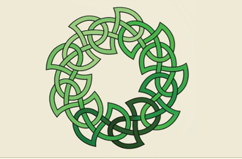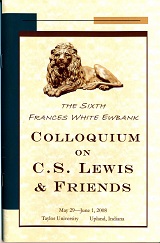Event Title
Session 5-B: Riddles and Meanings in Tolkien and Barfield
Location
Taylor University, Rupp 203
Start Date
31-5-2008 3:30 PM
Description
"The Riddle of Gollum: Was Tolkien Inspired by Old Norse Gold, the Jewish Golem, and the Christian Gospel?" - Woody Wendling
Tolkien’s sources for Gollum were most likely the same as his sources for ents—his love of word origins (philology), literature (poetry and prose), and life (personal experience). Gollum’s precursor in Tolkien’s writings was a creature named “Glip.” Gollum got his name from the sound he made when he spoke, “the horrible swallowing sound in his throat.” The hypothesis of Douglas Anderson, who annotated The Annotated Hobbit, is that Tolkien got the name Gollum from gull or goll, the Old Norse word for gold. One inflected form would be Gollum (gold, treasure, something precious). Another hypothesis is that Tolkien got the name Gollum from the Jewish Golem. The word golem occurs once in the Bible (Psalm 139:16) and is the origin of the Golem in Jewish folklore. The Gospel entered the story when Tolkien revised The Hobbit in 1951; Gollum becomes a fallen Hobbit in need of pity and mercy.
"A Journey of Self-Actualization: A Psychological Perspective on Own Barfield's This Ever Diverse Pair" - Lincoln Stannard
This paper presents a fresh analysis of one of Owen Barfield’s most unique fictional works, the semi-autobiographical This Ever Diverse Pair. Viewed within the historical context of Barfield’s period of practicing law, This Ever Diverse Pair contains evidence that the novel reflects Barfield’s psychological development during that time. This paper reveals that possibility through character study and examination of specific episodes in the novel. The contrasting personalities of characters Burgeon and Burden and the conflict and resolution of their partnership are used to portray the work as a dichotomous representation of Barfield’s personal growth, which is expressed in terms of Maslow’s theory of hierarchy of needs, especially the drive to self-actualize. Such as interpretation provides valuable insight into both the motive of Barfield as author and his personal experience during the trying middle epoch of his life.
"Tolkien, Turin, and the Language of Loss" - Zach Stone
This paper addresses the theme of loss as expressed by Tolkien in the story of Turin Turambar. The variations of this story are manifold, and have recently been collected into one narrative, The Children of Hurin,but this paper will examine the language Tolkien uses to express loss in the verse version of Turin's tale "The Lay of the Children of Hurin," as it is in verse that Tolkien most clearly articulates the language of this loss. I intend to situate the "Lay" predominantly in an Anglo-Saxon tradition of loss, but also consider the decidedly modern expression of loss as well, and perhaps the hope of recompense.
Moderator: Rachel Johnson
Event Type
Paper
Link to Papers
A Journey of Self-Actualization: a Psychological Perspective on Barfield's This Ever Diverse Pair
Tolkien, Turin, and the Language of Loss (Not available)
Session 5-B: Riddles and Meanings in Tolkien and Barfield
Taylor University, Rupp 203
"The Riddle of Gollum: Was Tolkien Inspired by Old Norse Gold, the Jewish Golem, and the Christian Gospel?" - Woody Wendling
Tolkien’s sources for Gollum were most likely the same as his sources for ents—his love of word origins (philology), literature (poetry and prose), and life (personal experience). Gollum’s precursor in Tolkien’s writings was a creature named “Glip.” Gollum got his name from the sound he made when he spoke, “the horrible swallowing sound in his throat.” The hypothesis of Douglas Anderson, who annotated The Annotated Hobbit, is that Tolkien got the name Gollum from gull or goll, the Old Norse word for gold. One inflected form would be Gollum (gold, treasure, something precious). Another hypothesis is that Tolkien got the name Gollum from the Jewish Golem. The word golem occurs once in the Bible (Psalm 139:16) and is the origin of the Golem in Jewish folklore. The Gospel entered the story when Tolkien revised The Hobbit in 1951; Gollum becomes a fallen Hobbit in need of pity and mercy.
"A Journey of Self-Actualization: A Psychological Perspective on Own Barfield's This Ever Diverse Pair" - Lincoln Stannard
This paper presents a fresh analysis of one of Owen Barfield’s most unique fictional works, the semi-autobiographical This Ever Diverse Pair. Viewed within the historical context of Barfield’s period of practicing law, This Ever Diverse Pair contains evidence that the novel reflects Barfield’s psychological development during that time. This paper reveals that possibility through character study and examination of specific episodes in the novel. The contrasting personalities of characters Burgeon and Burden and the conflict and resolution of their partnership are used to portray the work as a dichotomous representation of Barfield’s personal growth, which is expressed in terms of Maslow’s theory of hierarchy of needs, especially the drive to self-actualize. Such as interpretation provides valuable insight into both the motive of Barfield as author and his personal experience during the trying middle epoch of his life.
"Tolkien, Turin, and the Language of Loss" - Zach Stone
This paper addresses the theme of loss as expressed by Tolkien in the story of Turin Turambar. The variations of this story are manifold, and have recently been collected into one narrative, The Children of Hurin,but this paper will examine the language Tolkien uses to express loss in the verse version of Turin's tale "The Lay of the Children of Hurin," as it is in verse that Tolkien most clearly articulates the language of this loss. I intend to situate the "Lay" predominantly in an Anglo-Saxon tradition of loss, but also consider the decidedly modern expression of loss as well, and perhaps the hope of recompense.
Moderator: Rachel Johnson


